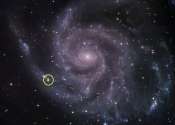NASA's Fermi mission sees no gamma rays from nearby supernova
A nearby supernova in 2023 offered astrophysicists an excellent opportunity to test ideas about how these types of explosions boost particles, called cosmic rays, to near light-speed. But surprisingly, NASA's Fermi Gamma-ray ...









